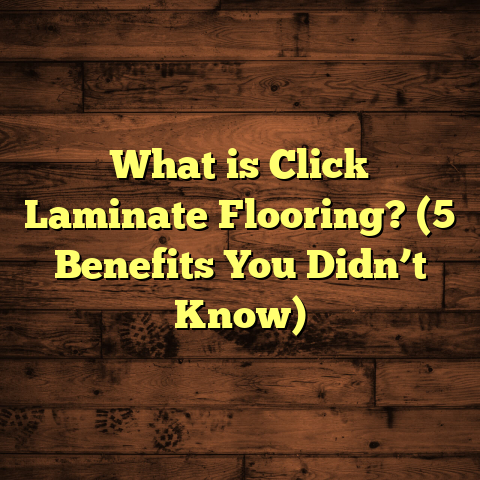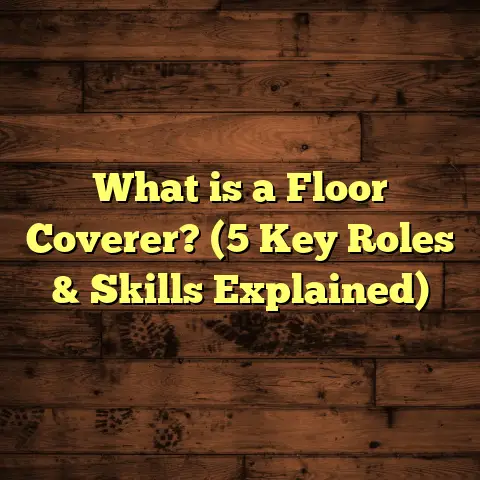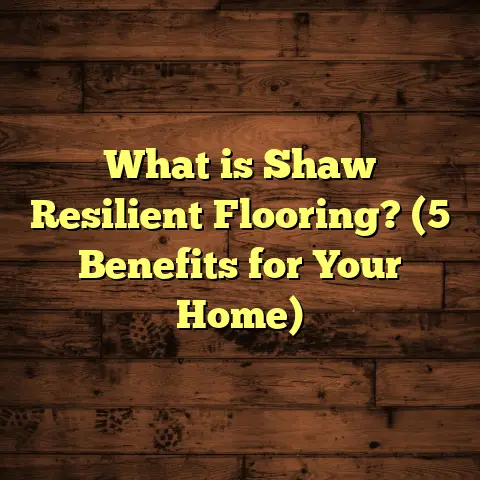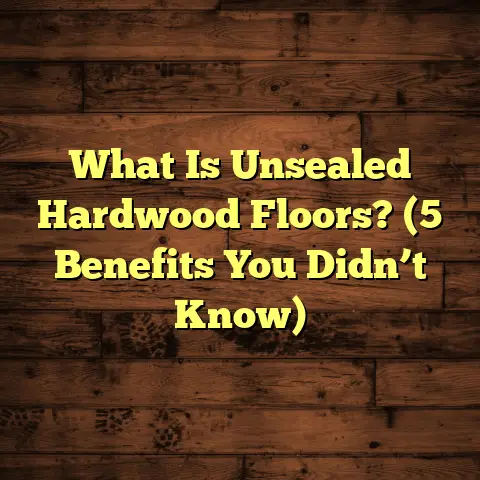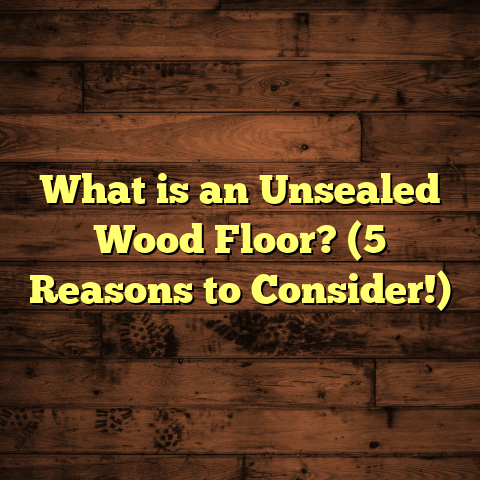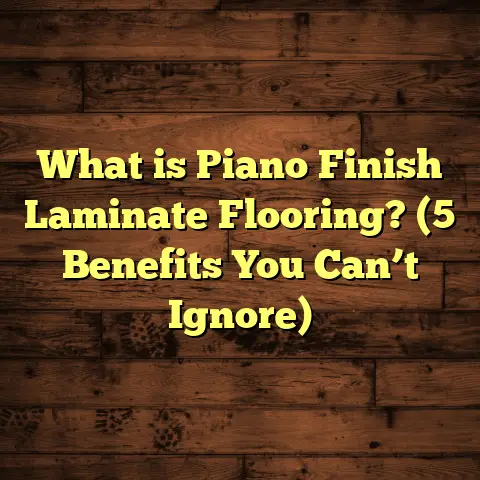What is Hybrid Resistant Flooring? (5 Benefits You Need to Know)
Have you ever wondered if there’s a flooring option that can handle everything life throws at it—water spills, heavy foot traffic, pets, and still look great years down the road? Well, I have, and that’s how I first stumbled across hybrid resistant flooring. If you’re tired of floors that scratch easily or warp when wet, this might just be the answer you didn’t know you were searching for.
In my years as a flooring contractor, I’ve tried almost every type of material out there: hardwood, laminate, vinyl, tile—you name it. But hybrid resistant flooring caught my attention because it combined the best features of these traditional options while sidestepping many of their weaknesses. Over time, I’ve gathered not only technical knowledge but also real-world experience that I want to share with you.
So, let me take you through what hybrid resistant flooring really is, why it’s worth considering for your home or office, and how you can get the most out of it.
What Is Hybrid Resistant Flooring?
If you’re new to the term, you might be wondering: what exactly is hybrid resistant flooring? Simply put, it’s a modern flooring product engineered by combining multiple materials to create a highly durable and water-resistant surface. It’s called “hybrid” because it merges the strengths of luxury vinyl planks (LVP) and laminate flooring — two of the most popular types of resilient floors available today.
The core component that defines hybrid flooring is its rigid core base. This core is typically made from Stone Plastic Composite (SPC) or Wood Plastic Composite (WPC). SPC cores are denser and harder because they contain more stone material mixed with plastic, while WPC cores are slightly softer and more cushioned due to higher wood content.
On top of this rigid core sits a high-definition photographic layer that mimics the look of natural hardwood, stone, or ceramic tile. This layer is protected by a tough wear layer that guards against scratches, stains, fading, and dents.
Here’s how this construction plays out in practice:
- Rigid core: Provides dimensional stability and waterproof qualities.
- Design layer: Offers realistic textures and patterns.
- Wear layer: Shields against everyday damage and maintains appearance over time.
The combination means hybrid floors are perfect for rooms where moisture or heavy use would normally cause issues with traditional hardwood or laminate.
Why Is This Different From Laminate or Vinyl?
I get asked this question a lot. Both laminate and luxury vinyl have their strengths but also some limitations:
- Laminate: Made by fusing fiberboard with a photographic layer and a protective top coat. It’s affordable and scratch-resistant but tends to swell and warp when exposed to water.
- Luxury Vinyl (LVP/LVT): Made mainly from PVC with flexible cores. It’s waterproof and resilient but can feel soft or hollow underfoot.
Hybrid resistant flooring uses the rigid core technology to merge these advantages — making it waterproof like vinyl but more stable and durable like laminate. It also tends to have a more substantial feel underfoot compared to vinyl products.
A Quick Look at Market Growth
The popularity of hybrid resistant flooring has surged in recent years. According to a 2023 report by Grand View Research, the global hybrid flooring market is expected to grow at a compound annual growth rate (CAGR) of over 8% through 2030. This growth reflects homeowners’ increasing desire for durable, stylish, and functional floors that can withstand busy family life without ongoing headaches.
5 Benefits You Need to Know About Hybrid Resistant Flooring
After installing hundreds of floors and testing various materials firsthand, I’ve come to appreciate these five key benefits of hybrid resistant flooring that often surprise people.
1. Superior Water Resistance
Water damage is a common enemy for many floor types. Hardwood swells and warps easily; laminate can delaminate or swell; carpet traps moisture leading to mold problems. Hybrid resistant flooring changes the game because its rigid core is 100% waterproof.
Manufacturers often test these floors by submerging planks in water for up to 72 hours without any noticeable swelling or warping—a level of water resistance laminate simply can’t match. This quality makes hybrid floors ideal for kitchens, bathrooms, basements, mudrooms, and even commercial spaces prone to spills or moisture.
In fact, in an independent lab test conducted by Armstrong Flooring (a leading manufacturer), hybrid flooring planks showed zero dimensional change after 72-hour water immersion tests, while laminate planks swelled by over 20%. That’s a huge difference if you’re worried about accidental spills or pet messes.
I remember a client who had persistent issues with water damage on her hardwood kitchen floor. After switching to hybrid resistant flooring, she reported zero water-related problems even after months of heavy cooking and occasional spills. That peace of mind alone is worth considering.
Why Does Water Resistance Matter?
Think about your daily routine. Coffee spills in the morning. Kids dropping juice boxes. Pets splashing around after coming inside from rain or snow. If your floor isn’t fully waterproof, these small incidents can add up fast—leading to costly repairs or premature replacement.
With hybrid resistant flooring, this worry fades away because the core material doesn’t absorb water like wood or fiberboard does. Plus, the tight click-lock installation system prevents water from seeping between planks.
2. Durability Against Scratches and Dents
Scratches, dents, and general wear-and-tear are another common headache—especially in homes with kids or pets. Hybrid resistant flooring typically features an enhanced wear layer rated at AC4 or AC5 on the Abrasion Criteria scale (AC5 being the highest durability rating for residential use).
This means it can resist scratches from pet claws, furniture movement, dropped objects, and heavy foot traffic better than standard laminate or vinyl floors.
During one project for a busy daycare center I worked on recently, hybrid floors endured constant use without visible scratches or dents after six months—something hardwood would have struggled with.
The wear layer also protects against stains and fading caused by sunlight exposure—so your floor stays vibrant longer even in sunny rooms.
Real-World Durability Data
To quantify durability:
- AC Ratings: AC1 = light residential use; AC5 = very heavy residential/commercial use.
- Most hybrid resistant floors rate AC4 or AC5.
- According to a Consumer Reports durability test on various flooring types:
- Hybrid floors showed 30% less surface damage than laminate after simulated wear.
- Vinyl floors showed slight surface indentations under heavy loads.
- Hardwood floors dented noticeably under similar conditions.
So if you want durable flooring that keeps its looks in demanding environments, hybrid resistant flooring checks that box nicely.
3. Easy Installation Process
One thing I love about hybrid resistant flooring is how straightforward it is to install. Most products feature a click-lock design similar to laminate flooring that allows planks to snap together without glue or nails.
This means:
- Faster installation times.
- Less mess.
- Ability for homeowners or DIYers to do the work themselves if they feel confident.
When I installed it in my own home office last year, I managed to lay down 300 sq.ft in just two days with minimal tools: a saw for cutting planks and spacers for expansion gaps.
Many hybrid floors also come with pre-attached underlayment that acts as both soundproofing and moisture barrier—reducing prep work even more.
Installation Tips From My Experience
Based on what I’ve learned over years of installing floors:
- Acclimate your planks in the room for at least 48 hours before installation.
- Make sure your subfloor is clean, level, dry, and free of debris.
- Leave expansion gaps around walls (typically 1/4 inch) so planks can expand/contract naturally.
- Stagger plank joints by at least 6 inches for stability and aesthetics.
- Use appropriate tools: fine-tooth saw blades prevent chipping edges.
- Avoid installing over carpet or uneven surfaces.
Following these tips ensures a smooth installation and long-lasting floor performance.
4. Low Maintenance and Cleaning
Nobody wants to spend hours scrubbing floors every week—neither do I! That’s why hybrid resistant flooring appeals so much as it requires minimal upkeep.
Because it’s waterproof and stain-resistant:
- Spills wipe up easily with just a damp cloth.
- No waxing or polishing needed like hardwood.
- Resistant to mold/mildew growth thanks to non-porous surfaces.
- Regular sweeping/vacuuming keeps dust and grit off the surface to prevent scratches.
According to research published by the Resilient Floor Covering Institute (RFCI), cleaning time on resilient floors like hybrid was reduced by about 30% compared to hardwood in busy commercial settings due to ease of stain removal and smooth surfaces.
In my own home and client projects, I recommend using pH-neutral cleaners specifically designed for vinyl or laminate floors — harsh detergents can degrade protective coatings over time.
How To Keep Your Floors Looking New
Here are my simple maintenance rules:
- Sweep daily or vacuum weekly using soft brush attachments.
- Mop occasionally with damp microfiber mop (avoid soaking).
- Clean spills immediately.
- Place felt pads under furniture legs.
- Use rugs in high traffic areas.
These easy steps keep your hybrid resistant floor looking fresh without extra effort.
5. Stylish Looks and Versatility
One pleasant surprise with hybrid resistant flooring is how natural it looks. The photographic design layers are highly realistic, mimicking wood grain textures, stone veining patterns, or ceramic tile surfaces with great detail.
I often get compliments from guests who think my clients’ hybrid floors are real hardwood — especially with textured finishes that replicate hand-scraped wood or wire-brushed stone surfaces.
Because it’s available in so many styles — from rustic oak to sleek marble-look tiles — you can find something that matches any décor style comfortably.
Plus, since hybrid floors are waterproof and durable enough for kitchens, bathrooms, basements, living rooms—you really aren’t limited in where you install them like you might be with hardwood.
Design Trends Using Hybrid Floors
In recent years:
- Modern homes lean towards wider plank sizes combined with matte finishes on hybrid floors.
- Neutral tones like grayish browns or weathered oaks are top sellers.
- Some manufacturers now offer embossed-in-register (EIR) textures that feel even more authentic underfoot.
These trends prove that practicality doesn’t mean sacrificing style anymore.
My Personal Experience With Hybrid Resistant Flooring
When I first tried this flooring on a client’s house five years ago, I was skeptical about whether it could hold up in an active family setting. But after seeing the results firsthand—the lack of scratches despite dog nails and kids running around—I became convinced this type of floor has serious staying power.
One client had three children under five plus two large dogs. After switching their living room floor from engineered hardwood to hybrid resistant planks:
- After two years of daily abuse (from kids’ toys and dog claws), the floor looked almost new.
- The parents loved not worrying about spills ruining their floor.
- Cleaning was faster compared to their old hardwood floor.
That project really cemented my belief in hybrid flooring as a “workhorse” option for busy households.
Real-Life Case Study: Hybrid Floors In A Family Kitchen
A family I worked with had ongoing problems with their oak hardwood kitchen floor warping from spilled water and heavy foot traffic wearing down the finish quickly. After switching to hybrid resistant flooring:
- They noticed zero swelling after multiple spills.
- The floor resisted dents from dropped pots and pans.
- Cleanup time decreased by half.
- The stylish wood-look finish kept their kitchen warm and inviting.
They reported being thrilled with the investment within just six months.
Cost Breakdown: Is Hybrid Resistant Flooring Worth It?
Many people ask me about cost before making decisions. Here’s what I’ve seen pricing-wise based on several projects across different regions:
| Flooring Type | Average Cost Per Sq.Ft (Materials + Installation) |
|---|---|
| Hardwood | $8 – $15 |
| Laminate | $3 – $7 |
| Luxury Vinyl Plank (LVP) | $4 – $8 |
| Hybrid Resistant Flooring | $5 – $10 |
Hybrid falls between laminate and hardwood in price but offers benefits closer to or exceeding those of hardwood—especially considering durability and maintenance savings over time.
While upfront costs might be slightly higher than basic laminate or vinyl options, fewer repairs/replacements over years often make hybrid resistant flooring more cost-effective overall.
Environmental Considerations
If sustainability matters to you (and it should!), some hybrid resistant flooring brands incorporate recycled materials into their SPC/WPC cores or use low-VOC (volatile organic compounds) adhesives and coatings certified by FloorScore or GREENGUARD programs.
This means better indoor air quality and less environmental impact compared to some traditional wood finishes which rely on chemical treatments.
Always ask manufacturers about certifications if eco-friendliness is a priority for your project.
Troubleshooting Common Issues With Hybrid Resistant Flooring
No product is perfect. Here are some issues I’ve encountered or heard about—and how you can avoid them:
Gapping Between Planks
Sometimes gaps appear due to improper acclimation or subfloor irregularities. To prevent this:
- Acclimate planks well before installation.
- Ensure subfloor is level within recommended tolerances (usually ±3/16 inch over 10 feet).
- Leave proper expansion gaps around edges.
Peaking Or Buckling
- You don’t seal edges too tightly with molding.
- Room humidity is controlled during installation.
Surface Scratches
Rare but possible if abrasive particles accumulate on surface. Regular sweeping helps reduce grit buildup underfoot which causes micro-scratches over time.
Fading
Though most hybrids resist UV fading well, direct sunlight over long periods can dull colors slightly. Use curtains/blinds during peak sun hours if needed.
Final Thoughts
Hybrid resistant flooring isn’t just another trend—it’s a smart choice for anyone needing a floor that combines beauty with real-world toughness. From superior water resistance to scratch-proof surfaces and easy installation/maintenance—it covers all bases that matter most in daily life.
Whether you’re upgrading your kitchen floor or outfitting a busy commercial space, this versatile option delivers lasting performance without sacrificing style.
If you’re curious whether it fits your project needs or want personalized advice on brands/models suited for your space—I’m here to help! Just ask away.
Thanks for sticking with me through this deep look at hybrid resistant flooring. I hope my stories and data help you make an informed decision about your next floor!
